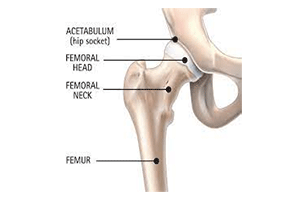If you’ve been diagnosed with bone loss in your hips, there are specific, evidence-based exercises that are known to help. We do a wide variety of hip strengthening exercises in our Strong Bones class, but for this blog I’ve highlighted three that are simple to do. I encourage you to practice them each and every day.
A DXA scan for measuring bone density at the hips typically includes scores for the total hip region as well as for the area called the “femoral neck.” This is the narrow area of the thigh bone (femur) just below the actual hip joint which is particularly vulnerable to fractures. The weight-bearing exercises I describe here are known to benefit this area as well as the hip in general.
SQUATS:
Squats strengthen the muscles and bones of the hip, thigh, and spine, and are also a key component of good body mechanics. Proper technique for this exercise is important for maximum benefit.
Basic Technique
Start with your feet about hips distance apart. Push your hips back behind you as you lower down. Your shins should stay nearly vertical, and the spine stays in a neutral (think straight) position. Repeat 10 times, but make sure you also use this technique whenever picking anything up from the floor.
I go into detail about this all-important exercise as it relates to body mechanics, in my September 2023 blog titled “Spine Sparing Strategies for Everyday Activities”.
HEEL DROPS:
The heel drop exercise generates ground reaction forces which, in turn, create muscle vibrations that stimulate bone growth in both the leg and hip area. These vibrations also occur during weight-bearing activities such as brisk walking or running.
Basic Technique
Stand tall and make sure you are near a sturdy object for balance as needed. Come partially up on the balls of your feet and then drop back down. The force with which you land is up to you, and I recommend experimenting with what feels like the right amount, especially at first. Repeat this rhythmically many times – 50 to 70 would be ideal and can be distributed throughout the day.
In a study comparing heel drops with jumping, box drops, and stomping, Montgomery and colleagues (1) found that heel drops were not only highly effective in stimulating bone growth, but also likely to be the most practical of the four options for the majority of people.
SINGLE LEG STANCE:
This simple and remarkably effective exercise not only improves balance but has also been found to improve hip bone density (2).
Basic Technique
Make sure you are near a sturdy object for balance as needed. Lift one foot and see how long you can balance on a single leg. Give yourself 3 chances to get your best result on each side. Refer to the table below for the statistical normative values per decade of life (3,4).
- Age 40-49 40.3 seconds
- Age 50-59 37.0 seconds
- Age 60-69 27.0 seconds
- Age 70-79 17.2 seconds
- Age 80-99 8.55 seconds
Sakamoto (5) determined that single limb stance captures 2.75 times the weight load to the femoral head (refer to the illustration above). He also determined that standing on one leg for one minute was found to be equivalent to the amount of load achieved through walking for approximately 53 minutes. In my opinion, that’s a remarkable payoff for very little effort!
Please keep in mind that you can’t feel your bones get weaker, so if you have pain in or around your hips, you may have tendonitis, bursitis, or good old-fashioned arthritis. Please reach out to your healthcare provider for guidance.
References
- Montgomery G. Et al. The Mechanical Loading and Muscle Activation of Four Common Exercises Used in Osteoporosis Prevention for Early Postmenopausal Women. Journal of Electromyography and Kinesiology 2019 February; 44:124-131.
- Hartley GW, et al. Physical Therapist Management of Patients with Suspected or Confirmed Osteoporosis. Journal of Geriatric Physical Therapy 2022 Apr-Jun 01;44(2):E106-E119.
- Bohannon RW. Single Limb Stance Times: A Descriptive Meta-analysis of Data from Individuals at Least 60 Years of Age. Topics in Geriatric Rehabilitation 2006 Jan;22(1):70-77.
- Springer BA, et al. Normative Values for the Unipedal Stance Test with Eyes Open and Closed. Journal of Geriatric Physical Therapy 2007;30(1):8-15.
- Sakamoto K. Effects of Unipedal Standing Balance Exercise on the Prevention of Falls and Hip Fracture. Clinical Calcium 2006 Dec;16(12):2027-2032.


